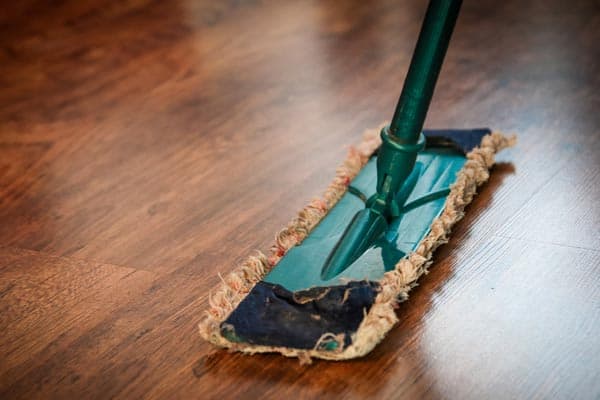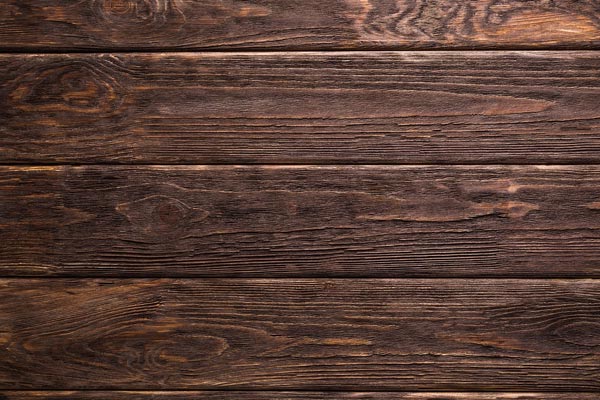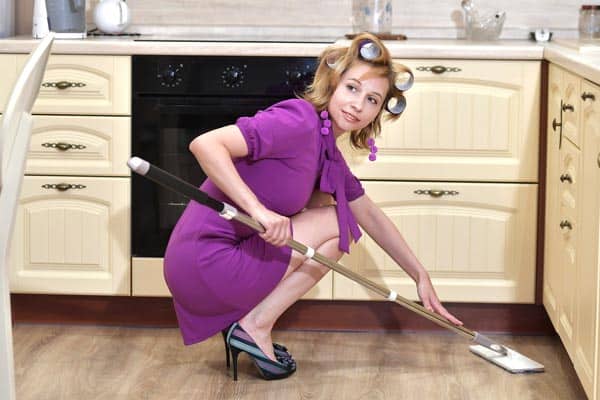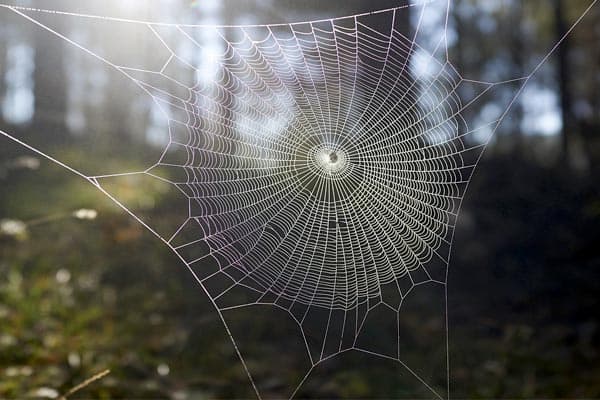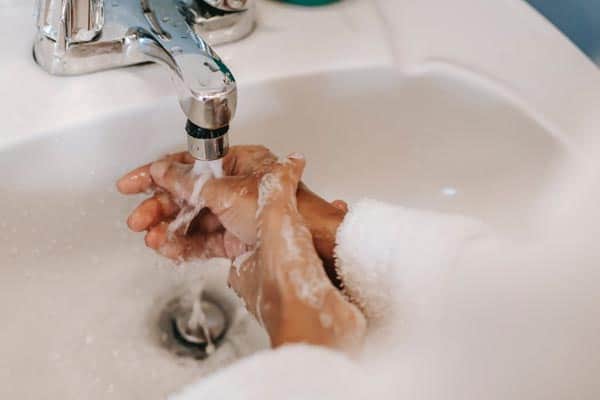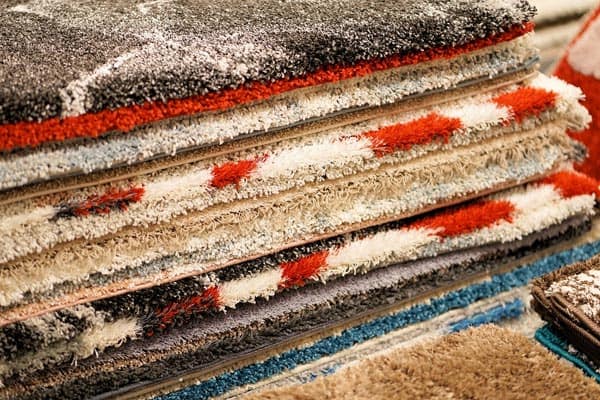How to Make Sure Your Kitchen Floor Isn’t Sticky After You Mop
When you mop your kitchen floor, you have the expectation that it’s going to be nice-smelling, clean, and non-sticky when you finish.
However, it’s very common for you to finish mopping, let it dry, and go to walk over it but find out that it’s still very sticky. This can happen on a host of different flooring types like tile, wood, or laminate, and it can be frustrating to try and clean it off.
So, how do you get the clean floors you want without having to deal with a sticky mess? I’m going to outline why the floor is sticky after you mop, how to clean your sticky floors properly, and more below.
Why Your Floor is Sticky After Mopping
You have to figure out what’s causing the sticky residue to stay on your floor before you can remedy it. This can take a process of trial and error because there are a few potential culprits that stand between you and non-sticky, clean floors.
I’ve picked out the biggest ones for you and outlined them below so you can go through them one by one and see which is your cause.
Stubborn Residue Sticks Through Mopping
The majority of the time, the sticky feeling on your freshly mopped floor is due to the stubborn residue that gets left behind, and this can include adhesive substances like glue, soft drinks, or grease that can attach to the floor.
Maybe you had grease in a frying pan that went through the air, ended up on the floor, and it combined with other chemicals to cause a quick oxidizing reaction that results in a sticky stain.
If you live in a cold climate during the winter months, salt and calcium chloride will dissolve into water and get sticky when you track it across the floor.
Neutral cleaners won’t work to cut through this mess and break down the chemicals, and mopping with plain hot water isn’t strong enough to remove the residue and dissolve the stain.
Many people tend to mop the same spot over and over, hoping that it’ll remove the sticky feeling, but it doesn’t always work properly.
Incorrect Cleaning Techniques
The second biggest reason you end up with a sticky feeling on your kitchen floor is that you don’t use the proper cleaning techniques.
You can’t pick a random chemical cleaner, pour it into your mop bucket, wipe it around the floor, and expect sparkling results. Instead, you have to learn to clean the correct way while you use the proper products.
Residual Cleaners
One of the biggest mistakes people make is that they purchase the wrong cleaners from the store that can leave more residue on your clean floors than other cleaners will leave.
For example, there are some cleaners that are a disinfectant that will help kill bacteria that are on your floor. However, it has a very thick formula with a sticky residue that will stay on your floors unless you wipe them up multiple times.
Too Strong Chemicals
Every chemical cleaner you can purchase either comes diluted and ready to go, or it has a recommended dilution ratio that you have to adhere to before you use it.
If you don’t dilute it enough, it can leave you with sticky flooring while lowering your floor’s durability factor because it strips helpful sealant away. If you use a soap-based cleaner, layers of this soap can build-up, dry, and cause stickiness when you walk over it.
Using Dirty Water
The more you mop your floors, the dirtier the water will be. When the water starts to turn colors or see noticeable dirt in the bucket, it’s time to switch out the new water.
If you don’t, all you’re managing to do is swish dirty water around your floor while introducing layers of grit that can turn sticky when it dries.
How to Clean Sticky Floors Properly
Fortunately, there are ways to work around this frustrating sticky feeling on your floors, and you can try the different options until you find the one that works best for your needs.
Change Your Cleaning Product and Mop More Frequently
The kitchen is arguably one of the busiest areas in the home, and this is especially true if you have small kids or a busy household.
If you think that the sticky residue is from accidental spills from cooking or beverages, make a point to mop more frequently while going over and over the stain to get them up off the flooring.
If you do mop frequently and you notice that your cleaner simply isn’t strong enough to cut through the grease and grime, start experimenting with other cleaning solutions.
For those that don’t want to use strong chemicals, a mixture of water and baking soda with hot water should be effective. Mix one cup of vinegar into one gallon of water and go over your floors with it to cut through the sticky feeling.
- Mix your vinegar into the water and stir it well.
- Soak a rag in your vinegar and water mixture for a few minutes before laying it over the sticky area.
- Leave the soaked rag to sit on the residue for 15 to 20 minutes to give the vinegar time to soften it up.
- Get your mop and clean up the sticky areas.
If this doesn’t strip the stains and sticky residue off of your flooring, you may need a stronger approach. We’ll outline it in the next section.
Consider Buying a Steam Mop
Traditional mops are great, but they don’t have the same power that you get with a high-quality steam mop. The steam from the mop is very effective at loosening up different stains, residues, or dirt so you can lift them away.
You do have to be very careful and adjust the heat to match your flooring so it won’t damage it. The hot steam can break the glue in your grout to cause your tile floor to float and chip.
Pick Out Less-Residue or Residue-Free Floor Cleaners
Your floor’s sticky residue could be coming from your cleaner itself if you’re not following the directions and diluting it properly before you use it. You may need to make the switch to lower-residue or residue-free cleaners to avoid that sticky feeling on your floor.
You will have to do your research about these types of cleaners so you know exactly which chemicals can leave residues. In turn, this will give you a good idea of which ones you want to avoid when you shop.
Dilute Your Cleaners Correctly
If you have too much cleaning solution in your mop bucket, it can eat away at your flooring or leave a sticky layer when it dries. You want to pay close attention to the manufacturer’s recommendations when you dilute your chemicals in your mop water.
It can be difficult if you get super concentrated cleaning solutions, but dilution control will help you figure it out. This results in:
- Savings – Measuring accurately will help increase your savings because you’ll use less product each time you mop, and your product will last longer every time you buy it.
- Safety – You won’t have to worry about breathing in caustic chemicals when you mop. Using the correct amount will also help to protect your floor from damage or sticky residues.
Wash Out the Mop Between Uses
You want to take steps to make sure that every tool you use to clean like your mop, rags, buckets, or cloth is dry and clean before you use them a second time.
If not, you’re going to end up with a very sticky floor when it dries. If your flooring is relatively clean, you should be able to mop the whole thing with a single bucket of water.
If you have a dirty floor, you’ll want to change the water out at least once or twice during your mopping process.
Anything sticky on the floor can act like glue that will combine with the dust and dirt you push around with your dirty mop water to create a grimy, sticky finished product. Rinsing out your mop head and swapping out the water can help you avoid this.
Whenever you see that the water is noticeably dirty, it’s a good idea to dump it out, rinse out the bucket and mop, and refill it with new hot, sudsy water. You should repeat this process until you can walk across your floor without worrying about sticking to it.
Follow the Correct Cleaning Techniques
One big thing you have to do is follow the correct cleaning techniques for your flooring type. Each type of floor has their own, and we’ll go over the three biggest ones below.
Wood Flooring
You can’t soak wood flooring when you mop it because it can result in swollen areas that shift. There’s also a protective sealant on the floor that strong chemicals can eat away at if you don’t dilute them correctly. To keep them clean, you’ll need to set up:
- Daily – Once a day, get a soft cloth or a microfiber mop and run it over your floor to remove hair, dust, dirt, and other unwanted particles. Not only will this make your floor look better, but it’ll also help protect it from scratches or damage. It’ll stop the stickiness from building up too.
- Weekly – Get a wet mop or a vacuum and clean your wood flooring once a week, and make sure that you get into any hard-to-reach areas. Be very careful not to scratch your flooring with the vacuum.
One thing that you want to do is to consider placing throw rugs on any high-traffic areas of your wood flooring to reduce the dirt buildup while protecting it from scratches. Don’t use water and vinegar on this type of flooring, and you should avoid soap-based or steam cleaning.
Tile Flooring
Tile flooring requires a little more upkeep due to having to contend with the grout and the tile itself. You’ll need to:
- Daily – Sweep or vacuum your tile flooring at least once a day or every other day to help remove dirt from the grout lines. The frequency in which you do this will depend on how busy your kitchen is.
- Weekly – Get a mild detergent or a mild all-purpose cleaner with a lint-free cloth and wash the floor once a week. You want to use vinegar and baking soda on the grout lines once a week to disinfect them and prevent discoloration.
You shouldn’t use a sponge mop on your tile flooring because it can scratch it and ruin the look, and you want to change the water often to prevent getting a grimy floor. You can buff the floor with a lint-free cloth when you finish cleaning it.
Vinyl Flooring
The final type of flooring I want to go to is vinyl flooring, and it’s a relatively low-maintenance choice. To keep it clean and non-sticky, you’ll have to:
- Daily – Get a soft broom and sweep your floor once a day to remove loose dirt, hair, or buildup. You can mix up warm water and shampoo to pick up hair.
- Weekly – Get a no-wax vinyl floor cleaner and mop your flooring once a week. You never want to use a lot of water on this type of flooring because it can lead to the glue letting go, cracks, or air bubbles.
One thing you can do with vinyl flooring is to get small throw rugs to the layout to give the dirt fewer places to settle. Also, don’t scrub hard at your flooring when you clean it because the glue can let go, and this can lead to the edges curling up.
Final Thoughts
Now you know the biggest reason why your kitchen floor can be sticky after you mop it, and I’ve also given you several ideas on what you can do to try and remedy it. Take care of your flooring, try a few of the methods I mentioned, and love the feel of your clean, non-sticky floor.
